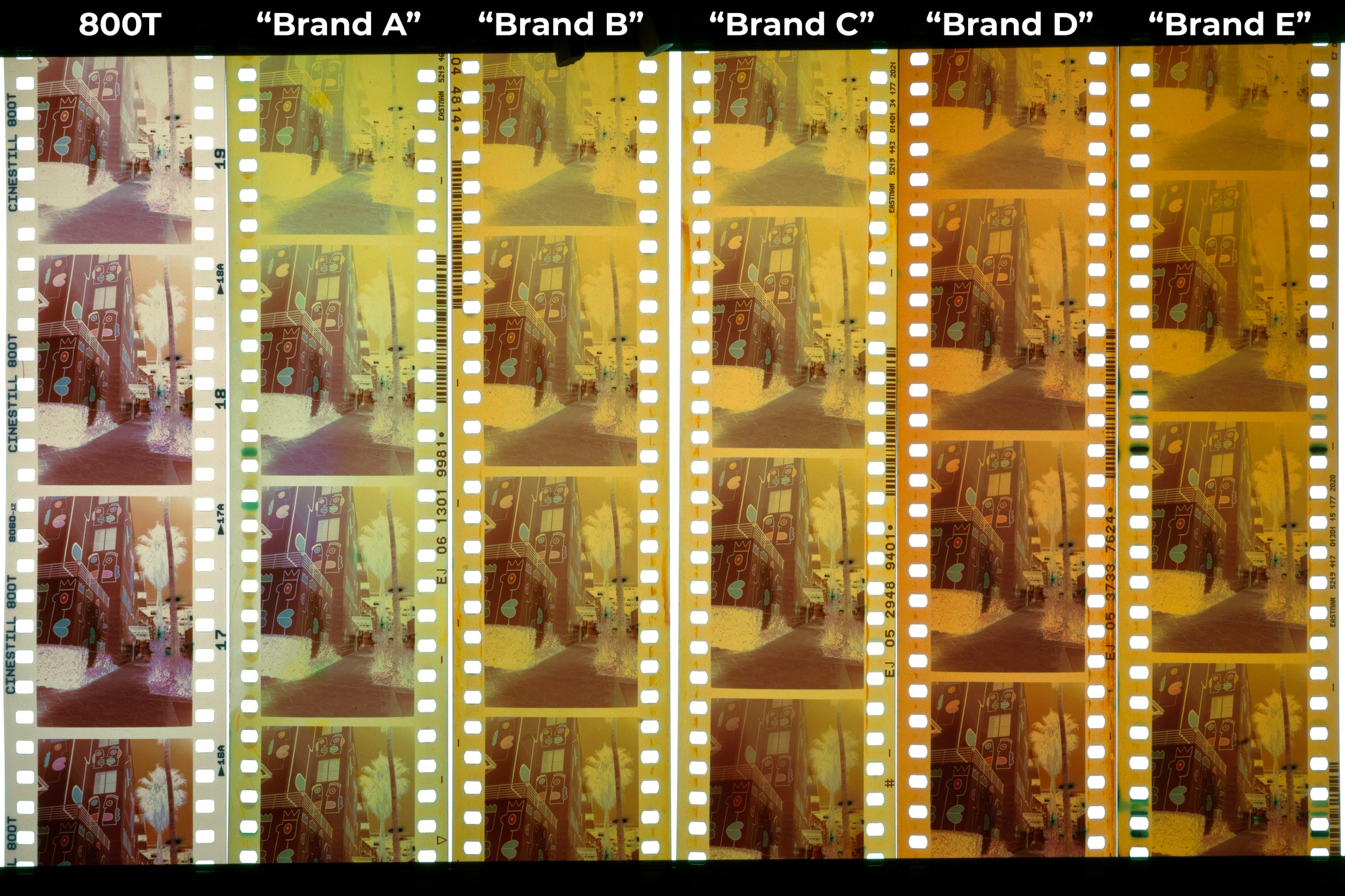News — High ISO
What Makes 800T the Original and Only True 800-Speed Tungsten-Balanced Film for Still Photography
Posted by CineStill on

When searching for CineStill films have you come across any “brand new” color films “made by” random brands lately? Are their claims strikingly similar somehow? Have they cracked the CineStill code? No, they have not… Through thorough quality assurance, we have concluded that true 800T — utilizing our meticulous and unique production process — is the only color film that can stand behind the claim of being both 800-speed and Tungsten balanced. This article will further explain how we came to this conclusion and go into detail showing the results of our extensive testing. We are not here to be nit-picky or point fingers and name names — which might get a little confusing — but some names may sound familiar to you by now. Those “800T” imitations and “400D” generics (repurposed from existing 500-speed or 250-speed motion picture film, respectively) are not representative of the original motion picture film’s quality nor the performance of CineStill films’ sensitivity and color fidelity. Although they may replicate the signature CineStill red halation glow, they are only somewhat comparable to expired film, in that they appear age fogged with shifted color-balance and exhibit a slower effective film-speed (200-400 ISO at best) resulting in a film not suitable for proposed use, let alone low-light photography; that is unless you like underexposed/expired film. For those looking for fresh film, we are fortunate to still have several other excellent high-speed color films available today (even with the recent unavailability of 400H and C200) — from UltraMax and Portra 400 to Lomo 800 and Portra 800 — but 800T is still the only tungsten-balanced, true 800-speed film made for still photography. Anything else, isn’t…
Read more →
No Compromises - Df96 compared with popular traditional developers
Posted by CineStill on
Due to the long history of multiple bath processes being the only ones available, many may wonder, "What are the compromises with a monobath?" Well, we can tell you that it is not compromised quality with Df96. We are standing on the shoulders of giants, and the reason monobaths weren't popular before is most likely because of economies of scale and cost, in addition to shorter shelf life. In the past, there was more profit in just producing the large volume photochemicals for film to be processed en masse. After all, back then everyone had to process film to capture a photo. Now that craft film manufacturing is being tooled for smaller batches, lower volume products can be more viable. Small batch, on demand, chemical manufacturing works just like craft beer. Fresher product with more characteristics. Thus the modern monobath was born, formulated to be produced at a craft scale.
Df96 is very forgiving for all film speeds and different emulsion types. This is partially because of the advanced developing agents used. But also as chemical development self-completes, archival fixation takes over breaking down silver and allowing physical development to redeposit it in thin areas of the film, while diffusing the grain to be finer and smoother. As you can see in the samples below, it renders somewhere between the Ilfotec DDX grain structure and Kodak Professional HC-110 tonality.
Detail crop of BwXX processed at ISO 250 in HC-110 liquid concentrate, Df96 monobath, and D-76 powder chemicals.


Detail crop of BwXX processed at ISO 250 in DD-X liquid concentrate, Df96 monobath, and ID-11 powder chemicals. 


Df96 also works well with tabular grain films, like Tmax, but to fully eliminate residual color dyes in the emulsion we double the recommended processing time. This does not affect the image since all films complete development within the first 3 minutes. Below you can see the smoothness and crisp contrast Df96 pulls out of TMax100...
Read more →
Processing 16+ different B&W films with just one chemical! Df96
Posted by CineStill on
Out of all of the available processes we've had the pleasure of using, Df96 is possibly the most uniform and consistent with all emulsions. It's not only a single-step solution, it makes over processing virtually impossible. We decided to test processing over 16 different emulsions exposed at their box speed, in one bath, at the same time, at the same temperature. Df96 has terrific uniformity due to the simultaneous development and fixing of the silver, competing to reveal every detail, from the most subtle to extreme exposure.



Df96 monobath easily processes any standard black and white film at any room temperature. It is designed with traditional cubic-grain emulsions in mind, like BwXX, TriX and HP5. It also works well with tabular grain films containing color dye technology, like Tmax, but to eliminate residual dyes in the emulsion you should double the recommended processing time. High speed films like P3200 and Delta3200 can be processed between ISO 1000-1600 by the instructions on the label, or pushed to 3200 by adding 10°F (6°C)....
Read more →
CineStill 800T In Your Toolbox
Posted by CineStill on

CineStill 800T was originally based on a motion picture emulsion designed for shooting in limited artificial, continuous, incandescent light. It can also be shot in daylight with the appropriate “85” filter, or with a warmer “85b” filter in blue cast shade. It is also popular to shoot 800T with no filter for a cool look, or to be color corrected warm for a Wes Anderson aesthetic. This film is optimized for a hybrid workflow, ideal for scanning, but comparable with standard still photography processing and darkroom printing, with literally futuristic features (from a still photography perspective)....
Read more →
Announcing the Rebirth of Kodak Tmax P3200 TMZ for Preorder!
Posted by CineStill on
ROCHESTER, N.Y. February 23, 2018 – After 5 years of "darkness" for high speed black and white film emulsions, Kodak has proclaimed the end of the "Dark Ages" and onward to the "Film Renaissance" with the rebirth of one of the most unique films on the market!
Tmax P3200 35mm available to ship in March, 2018
KODAK PROFESSIONAL T-MAX P3200 Black & White Negative Film ⁄ 3200TMZ is a multi-speed continuous-tone panchromatic black-and-white negative film that combines high to ultra-high film speeds with finer grain than that of other fast black-and-white films. It is especially useful for very fast action; for dimly lighted scenes where you can’t use flash; for subjects that require good depth of field combined with fast shutter speeds; and for handholding telephoto lenses for fast action or in dim light. It is an excellent choice for nighttime photography.
Features and Benefits:
- KODAK T-GRAIN Emulsion
- High to Ultra High speed
- Fine grain
- Superior sharpness
- Maintains subject detail in prints higher degrees of magnification than conventional films
To preorder this reanimated film stock simply add it to your cart from our product page.
“It’s no secret that we’ve been looking for opportunities to expand our portfolio” said Dennis Olbrich, President – Kodak Alaris Paper, Photo Chemicals and Film. “Darkroom photography is making a comeback, and B&W Film sales are clearly on a positive trajectory. Given these very encouraging market trends, we believe P3200 TMZ will be a great addition to our lineup”.
Read more →
Prerelease of 120 800T for Retail!
Posted by CineStill on
CineStill in MEDIUM FORMAT is here!!!
Be among the first to get your 800T 120 by preordering here. Supplies are limited, so order now before...
Read more →
A DP's Point of View - CineStill 50D & 800T by Rob Hauer
Posted by CineStill on
 |
| CineStill 50Daylight |
You may recognize the above image by Rob Hauer from our web site sample images of our 50Daylight emulsion. Rob was an early tester of our CineStill 50Daylight emulsion, but since then he has continued to capture beautiful images on CineStill 50D and 800T with an incredible eye for composition and light! It is really interesting to see what a director of photography does with...
Read more →
Kickstart Medium Format CineStill Film! - The BIG announcement
Posted by CineStill on


